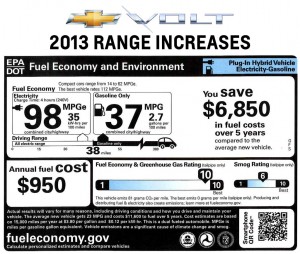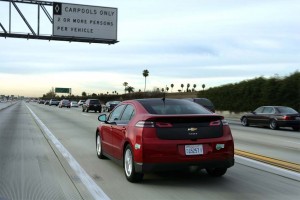The Chevrolet Volt will be able to go an extra 3 miles – about 10% — further per charge when the 2013 models roll into dealer showrooms. Meanwhile, the EPA is increasing the plug-in hybrid’s rated fuel economy to 98 MPGe.
General Motors is clearly hoping that help boost demand for the Volt. Sales have risen significantly over year-ago levels, but demand for the Volt is still lagging well behind what the Detroit maker forecast for 2012.
The 2013 Chevy Volt will get an estimated 38 miles per charge before the plug-in’s gasoline motor fires up and takes over, an increase of 3 miles compared to the 2012 Volt. Meanwhile, fuel economy jumps from 94 MPGe to 98.
 Short for “miles per gallon-equivalent,” that figure is the result of a complex calculation that takes into account such things as the size of the vehicle’s battery pack and the amount of energy used for a given distance. The EPA estimates a gallon of gas is equivalent to 33.7 kilowatt-hours of electricity.
Short for “miles per gallon-equivalent,” that figure is the result of a complex calculation that takes into account such things as the size of the vehicle’s battery pack and the amount of energy used for a given distance. The EPA estimates a gallon of gas is equivalent to 33.7 kilowatt-hours of electricity.
That means the Volt will have the equivalent of just over a half a gallon of gas in its battery pack for 2013. In more traditional terms, the 2013 model will get a larger 16.5 kWh pack compared to the outgoing 2012 plug-in’s 16 kWh of batteries. And while the basic chemistry of the pack remains the same – a manganese-based version of lithium-ion – GM says it has made some minor tweaks to improve performance and durability.
“The best way to explain what we’ve done at the cell level is to compare it to a cake batter recipe. Sometimes if you use more sugar and less vanilla you get a better tasting cake. We’ve done some work at the cell level to modify the ‘ingredients’ to make a better end result,” said Bill Wallace, GM director of Global Battery Systems Engineering. “This attention to detail will allow our customers to experience more pure EV range, which is the true benefit of owning a Volt.”
Like most battery vehicles, the Chevrolet Volt uses only part of the total capacity of its T-shaped lithium-ion pack. That’s because lithium batteries neither like to be fully charged or fully discharged if they are going to deliver maximum durability. Volt’s so-called state-of-charge window will increase from 10.3 kWh to 10.8 kWh for 2013.
Chevy says the larger battery will now take slightly longer to charge: 10.5 hours on a 120-volt circuit and about 4.25 hours using a 240-volt line.
The Chevrolet Volt’s upgrade comes the same week Honda revealed it had won a 118 MPGe rating from the EPA – the highest figure ever recorded – for its new Fit EV. Unlike Volt, that model is a pure batter-electric vehicle, with no back-up generator onboard. The EPA says the 2013 Honda Fit EV should get an average 76 miles per charge.
Chevy hasn’t released pricing for the 2013 Volt, though it actually dropped the MSRP slightly for 2012 and has hinted its goal is to continue dropping the cost of its battery-based vehicles as volumes increase.
The maker sold 1,680 Volts in May, up from just 481 the year before. That increase reflects a variety of factors, including the fact that Volt is now available in all 50 states, rather than select launch markets, and the fact that it is now available in California in P-ZEV form – which means an owner can drive it in the state’s carpool lanes even with only one person aboard.
But Chevy will have to achieve far more growth if it’s to meet the 2012 target of 45,000 Volts in the U.S.


